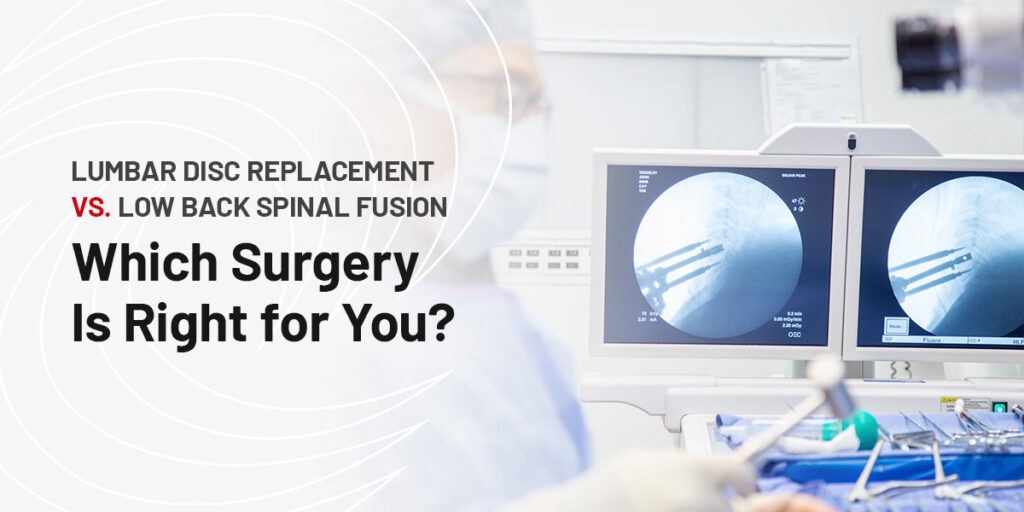
Deciding between lumbar artificial disc replacement (ADR) and lumbar spinal fusion surgery is a critical choice that can significantly impact your quality of life and recovery. Both procedures aim to address degenerative disc disease but differ in their approaches and outcomes.
ADR focuses on replacing the damaged disc with an artificial one, which helps maintain spinal motion and potentially offers a quicker recovery. In contrast, spinal fusion stabilizes the spine by permanently connecting two or more vertebrae. This procedure can effectively address more complex spinal issues but may come with a longer recovery time and the risk of adjacent segment degeneration.
To determine the best option for you, consider factors such as age, activity level, the severity of spinal degeneration, and the expertise of your spine surgeon. Consulting with a specialist, such as those at the Desert Institute for Spine Care in Phoenix, can provide valuable insights and a second opinion, ensuring you choose the most suitable procedure for your specific condition and needs.
Before opting for surgery, the treatment of Degenerative Disc Disease (DDD) should prioritize noninvasive or minimally invasive approaches. Surgery for DDD is often viewed as a last resort, typically considered only after extensive conservative treatments, such as physical therapy and anti-inflammatory medications, have failed to provide relief.
Spinal fusion has traditionally been the standard surgical option for DDD when surgery becomes necessary. The primary goal of spinal fusion is to stabilize the spine by fusing two or more vertebrae, reducing motion that may be causing pain, and correcting any spinal deformities. In this procedure, a damaged disc is removed and replaced with a bone graft, encouraging bone growth. Over time, the gap left by the removed disc fills with bone, effectively fusing the vertebrae.
Lumbar artificial disc replacement is a procedure similar to knee or hip replacements but focusing on preserving spinal mobility by replacing a damaged disc with an artificial one. Unlike other joint replacements where the causes of pain are well understood, the source of low back pain is less clear. This surgery involves a coordinated effort between a vascular surgeon, who first makes an incision in the abdomen and moves aside critical organs to access the lumbar spine, and a spine surgeon, who then removes the damaged disc and replaces it with an artificial one designed to mimic the function of a healthy disc.
Ideal candidates for artificial spinal disc replacement include those who:
Surgeons most often recommend ADR when the primary issue is low back pain originating from a specific disc or discs and the patient doesn’t have significant spinal deformities such as scoliosis. Additionally, ADR may be suitable for maintaining spinal mobility, as this procedure aims to preserve motion at the affected spinal levels, potentially reducing the risk of adjacent segment disease (ASD) that can occur after spinal fusion.
Lumbar ADR may be a viable solution under clinical indications like:
Lumbar artificial disc replacement is not suitable for everyone, as specific contraindications can make a patient ineligible for the procedure. Absolute contraindications can complicate the surgery and its outcomes and include:
Artificial spinal disc replacement may also not be viable for those with conditions like:
Relative contraindications can also influence the decision for ADR, as these factors may increase the risks associated with the surgery and impact the recovery process. These include:
Lumbar artificial disc replacement is a surgical procedure designed to alleviate pain and restore function for patients with degenerative disc disease. As with all surgeries, there are pros and cons to consider.
Significant advantages of spinal disc replacement include:
However, there are also notable disadvantages of ADR, including:
Candidates for lumbar spine fusion surgery are typically:
The decision for surgery is generally made after a comprehensive evaluation by a spinal specialist, who assesses the severity of the condition, the patient’s overall health, and the effectiveness of other treatments.
Clinical indications for spinal fusion include patients with:
Weighing the advantages and disadvantages of this procedure can help you make a more informed decision.
Lumbar fusion surgery offers several advantages, including:
However, there are notable drawbacks:
When considering lumbar spine surgery, there are several factors to evaluate before choosing, including:
The study titled “Comparison of Lumbar Total Disc Replacement With Surgical Spinal Fusion for the Treatment of Single-Level Degenerative Disc Disease: A Meta-Analysis of 5-Year Outcomes From Randomized Controlled Trials” conducted a meta-analysis to compare the outcomes of lumbar total disc replacement (TDR) and spinal fusion for treating single-level degenerative disc disease.
The findings suggest that, over five years, TDR resulted in similar or slightly better outcomes in pain relief, functional improvement, and patient satisfaction than spinal fusion. Additionally, TDR showed a lower incidence of adjacent segment disease, making it a viable alternative to spinal fusion for suitable candidates.
Getting a surgical consultation or second opinion with the Desert Institute for Spine Care in Phoenix offers several key benefits. The institute is known for its specialized expertise in spine care, providing comprehensive evaluations and advanced treatment options tailored to individual patient needs. Consulting with their team can help clarify the diagnosis and explore all potential treatment options, ensuring you make an informed decision about your care.
Additionally, obtaining a second opinion can provide reassurance and confirm that the recommended surgical approach is the most appropriate for your condition. The institute’s reputation for cutting-edge techniques and a patient-centered approach can contribute to better outcomes and a clearer understanding of the benefits and risks associated with spine surgery.